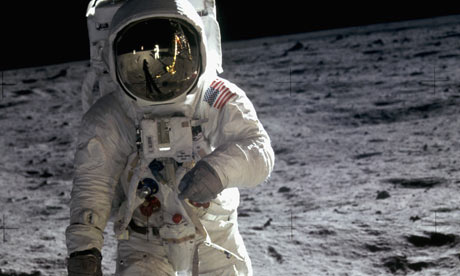"Magnificent desolation" was how Apollo 11's Buzz Aldrin described the moon's Sea of Tranquillity just before he took his first small step in July 1969. This, of course, is the space mission that is burned into our collective memory. But Michael Light, the man behind the book Full Moon, which uses the astronauts' original photographs to illustrate the Apollo programme, and who also orchestrated the accompanying exhibition at London's Hayward Gallery, argues that it was "by far the dullest" out of the 12 missions.
"Apollo 11 was about test-piloting a machine onto an alien surface, hopping outside very briefly, then hauling ass back in and getting the hell out of there before anyone died," Light explains. It was too dangerous to take exploration equipment, or to ask the astronauts to record the moon's startling desolation on film.
By the time of Apollo 17 in 1972, they had dug, sampled and surveyed the moon's virginal, if pockmarked, surface, hurtling back with 838lb of lunar rock, TV and video footage and more than 32,000 photos.
Taken in a world without atmosphere, the stills were infused with a light sharper and stronger than anything the eye, or camera film, had evolved to handle. The blacks are so intense that a special ink had to be made for Light's book. For the exhibition, the artist blew them up into panoramas up to 24ft wide, "to take people as close as they can get to the moon without going Disneyland".
The detailed information they revealed has proved infinitely more valuable to scientists than any of the much lower-resolution moving images. This should not come as a surprise: photography grew out of chemistry and physics and continues to be bound up with science. The reason the Apollo images are striking as well as useful is that natural conditions - what Light calls the "insanely distilled" lunar environment - can distort images of reality as much as can human manipulation.
The space photography process was kickstarted in 1962 by John Glenn, an astronaut on the early Mercury programme. Realising that America's first orbital spaceflight merited a few snaps, he bought a cheap 35mm camera at a drugstore on Cocoa Beach in Florida. By the time of Apollo, photography had become an established research tool. Its importance had even been recognised by the President. In 1967, Lyndon Johnson said that if nothing else had come out of the early space programme other than "the knowledge we've gained from space photography", it would still have been worth "10 times" the $35bn spent on the whole shebang.
The Apollo process was marginally less primitive: the astronauts were equipped with chest-mounted medium-format 70mm Hasselblads with oversized controls, which they had to manipulate with their bulky space gloves. They were under immense pressure of time and money.
Many of the images are neutral, but all are determined by what the individual eye plucked out from the wilderness. A few are more emotive: Charles Duke snapped a plastic-wrapped photo of his family lying on the lunar soil. In others, the inky shadow of the colonising American looms large over the terrain.
Fascinated by places where "humans are at last dwarfed by their [natural] surroundings", Light - once an environmentalist before he became a photographic artist - previously explored his interest in landscapes through aerial photography. For Full Moon, he sifted through all 32,000 of the Nasa photos where they lie in a public access archive. Frustrated with the substandard "dupes of dupes of dupes" which you can obtain from Nasa for a nominal fee, Light negotiated with the agency to take the masters offsite for the first time ever, in order to digitally scan them at film-grain resolution. Light calls the results "clones" rather than copy negatives.
Light calls himself a "cultural interventionist". He did not take the photographs: he edited and sequenced them. He touched up the "gazillion black specks" on the negs, once or twice removed the "reseau" (reference) line grid, and made the negatives "sing" as prints, while leaving the score (as Ansell Adams termed negatives) intact. What's left are essentially cleaned-up originals both in the book and on the gallery walls.
While many contemporary artists utilise scientific methods, or feed off science's ideas, it is rare that archival scientific images are put virtually unadulterated onto the wall. There are occasional precedents: German artist Thomas Ruff, for example, has blown up archival star-mapping images to a vast scale and transformed them into metaphysical meditations. What is it about these, and particularly the Apollo pictures that allows them to hang quite happily in a gallery rather than a museum? Is it their aesthetic strangeness, our innate fascination with worlds at the furthest reaches of human exploration, or simply the fact that they mark a unique historical landmark?
"It's a combination of all three," says Light. "But I would wager that these images would not look so stunning in an aerospace museum next to lots of rockets." If this is the case, scientific images of oceans, mountains and polar wastes might be ripe for similar treatment. "Archival work is fascinating because it's like a huge playpen containing sublime images," continues Light. But the moon as the furthest place we have yet explored in person remains the ultimate imaginative playpen.
The book Full Moon is published by Jonathan Cape, price £35. The exhibition is at the Hayward Gallery, London SE1 (0171-928 3144), till September 19.







